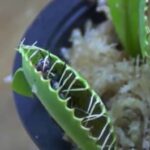As an Amazon Associate, this site earns commissions from qualifying purchases. For more details, click here.
Sundews, as you probably know, require lots of water to grow. These plants like wet conditions sure, but is it possible to overwater it? This guide is going to explain what you need to know so your sundews are not over or under watered. And the rules are quite simple actually.
Sundews prefer high humidity and watery soil, so overwatering is difficult. The best way to water sundews is to use the tray method, but make sure to use only purified, reverse osmosis water or rainwater.
How Much Water Do Sundews Need?
Sundews need water to grow, but too much of it makes the plant vulnerable to fungal or bacterial infection. This applies not just to sundews but other carnivorous plants like Venus flytraps.
How much water do sundews need? Enough to keep the soil constantly moist. The lower the humidity, the more water sundew plants require. So you have to consider the environment the plant is in. Unless you live in an extremely humid place, overwatering sundews is unlikely.
There are two ways to water sundews: the tray method and top water.
Tray Method
For the tray method you will need:
- A tray
- Pot with drainage (5-10 inches high)
- Water (purified, rainwater or reverse osmosis). Bay Bay Water is good choice too.
All you have to do is place the pot where the sundew is planted in the tray. For a 6 inch pot, fill the tray with 1/2 to an inch of water. You can add more if the pot is taller or there is low humidity in the area.
The water will seep into the container drain hole, nourishing the plant. When the water evaporates, add more. How often this needs to be done depends on the season and humidity.
Some sundew growers like to add more water, as much as half the size of the pot. However you should start with 1/2 to an inch and add more if it looks like your sundews could use more. Dry, leaves and lack of dew are signs the plant could use more water.
Let the tray dry out at least once a month to kill possible plant disease. That is basically all the maintenance needed for the tray method.
This is why it is very popular among new sundew growers and even seasoned cultivators. However it is still a good idea to top water every couple of months to wash away minerals that might have accumulated in the soil.
Top Water
Top water means watering from above. This is how most houseplants are watered and it can be done with sundews as well.
As water pours down to the plant, it reaches the soil and releases oxygen. This process helps plants grow including sundews.
So why is the tray method more popular? Because it is easier to refill a tray than estimate if you have watered the plant enough. It is very easy to overwater from the top compared to the tray method, which is why most people prefer it.
What Type of Water Should I Use on Sundews?
The type of water you use can literally make the difference between a healthy sundew and a dead one. For the best results we recommend using only the following:
- reverse osmosis water
- rainwater
- distilled or purified water
- spring water
Any water that is devoid of minerals is good for sundews. Minerals in hard water can be particularly harmful to plants, carnivorous or not.
Tap water is widely used to water plants, but the long term negative effects on sundews cannot be ignored. Chlorine is bad for plants in general and hard water will leave mineral deposits on the soil. This buildup looks like white crust and can slow plant growth.
If you are going to grow sundew plants, use mineral free water. While tap water is cheaper and readily available, you will pay more when your sundew dies and you have to start over.
Do Sundews Need Less Water During Dormancy?
Some sundews go into dormancy and if yours is one of those, will it need watering? Yes, but you have to reduce the amount.
Sundews that go into dormancy should be watered to keep the soil lightly moist. Never let the soil completely dry, even during this time. But use only just enough water to keep the soil from drying out.
If you are going to use the tray method, reduce the amount of water. You might need to do some trial and error here. Add half an inch of water and check the soil. As long as it is not totally dry, that is enough.
Most sundews that go dormant exhibit signs during fall and hibernate the entire winter. But arctic variants do the opposite and go dormant in summer.
Buy tropical sundews if you do not want to deal with dormancy. Some temperate sundews go dormant but others do not, so check what species you buy. Cape sundews are the easiest species to grow so it is the most suitable for beginners.
Tips For Growing Healthy Sundews
Even if you use the right type and amount of water, there are other factors that you have to consider. The following should be applied when growing any drosera variant to ensure growth and resistance to disease.
Humidity and Sunlight
The rule is simple: sundews prefer high humidity, and the higher the humidity the less water is needed. The opposite is also true: growing sundews in a dry, low humid location will require more water.
The best place to grow sundews indoors is to place it on a sunlit window. The more sunlight a sundew gets the better. The absolute minimum is 6 hours, 12 hours or more is preferable. You can also use Feit Electric Grow Lights if you are nurturing the sundews indoors.
But if the temperature is too high water will dry quickly. Provide the plant with as much light as possible, but keep its environment damp.
Use artificial light if natural is not possible. Dry, arid environments is not good for sundews and a humidifier can help.
Nutrients and Food
Sundews can create their own food through photosynthesis. This is only possible if the plant has access to light, air and enough water. During the summer you have to ensure the soil does not dry up due to the heat.
Sundews get their nutrients from insects. They can eat about 4 bugs a month, so it is normal to see at least one tentacle always closed. If the tentacles are always open, the plant is not healthy.
Sundews outdoors can get all the insects they need without help. If your plant is indoors, you can give it fish pellets, mealworms and other freeze dried foods for plants.
This is why the tray method is so effective. You can keep the sundew exposed to indoor or outdoor light, but the pot is immersed in water. This also eliminates the need for misting.
Soil and Pot
When it comes to soil, use equal parts peat moss and perlite. You can also use one part silica sand and sphagnum. Never use rich or enhanced soil as it could kill your plant.
When you have chosen a soil combination, mix it thoroughly. Add as much water as needed to ensure the two elements are thoroughly mixed.
Plant containers come in a wide variety of sizes, though 5 and 10 inches are the most popular. The larger the sundew the taller the pot has to be.
The taller the pot, the more water you will need to use with the tray method. As stated earlier you also have to account for the humidity. In general, sundews soak up water well and it would take a lot to overwater it.
Conclusion
Growing sundews is not as difficult as it seems provided you do research first. It starts by knowing what variant you have and setting up the ideal conditions. By using the principles in this article, you can water your sundews with confidence.

My fascination with carnivorous plants began many, many years ago with Venus Fly Traps. Now I am more than happy to impart what I know with other enthusiasts and those who are curious about meat eating plants.



